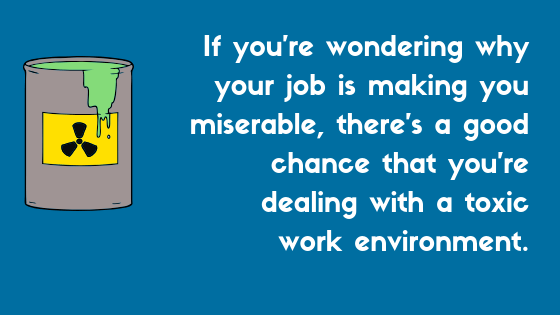Toxic Work Environment: Signs of Unhealthy Work Culture

9 min read

In a perfect world, the workplace would feel like a pleasant, respectful, and mission-focused environment. Employees would be free to focus on using their talents to the best of their abilities, in pursuit of a singular common goal. In that ideal environment, the only stress you would experience would be related to the job. Unfortunately, this is not a perfect world. Far too often, the workplace can be a negative environment that makes it almost impossible for employees to achieve their true potential.
In this post, we will explore the concept of a toxic work environment and some of the physical signs you may experience when you find yourself in that type of setting. We will also examine some of the best things you can do to deal with toxicity in your workplace.
What is a toxic work environment?
A toxic workplace is any work environment where the people, culture, and atmosphere are so negative that it disrupts the company’s efforts and even spills over into employees’ personal lives. Sadly, however, too many people fail to recognize the signs of toxicity. Fewer still understand how to fix a toxic work environment.
What are the physical signs of a toxic work environment?
Often the first signs indicating that something is amiss manifest as physical symptoms for the employee. Mental stress can impact your physical health, draining your energy and causing you to feel uneasy at work and at home. Much of this is due to the natural human response to any stress – the fight or flight instinct that kicks in whenever your body and mind believe that you’re in danger. Over time, that constant state of unease can cause serious physical symptoms. For example:
You may struggle to sleep at night as your mind lingers on negative emotions from work
Sometimes, you may even feel unsafe, on edge, or suffer from a sense of impending dread
Your stress levels may increase, affecting your eating habits and overall mental health.
These health problems are all symptoms of workplace toxicity following you into every area of your personal life. When you experience any of these physical symptoms, it’s important to take time to determine whether your workplace has become toxic. Begin by considering the chief toxic work environment characteristics and whether your workplace exhibits those attributes.

The top signs of a toxic work environment
1. Ineffective leadership
One of the most obvious signs of a toxic work environment involves ineffective leadership. Ask yourself the following questions:
Are the leaders and managers in your company narcissists?
Has your boss created multiple standards that are applied unequally?
Do superiors reject constructive criticism and only listen to their own counsel?
Worse, are they neglectful and dismissive toward subordinates?
If the answer to any of these questions is yes, it’s almost a given that their attitudes help to foster a toxic work environment.
2. A lack of positive communication
You might also notice a breakdown in positive communication among your colleagues and managers. Take time to examine the lines of communication in your workplace and look for these indications that something’s wrong:
Is there low morale?
Are people ignoring their co-workers around the office?
Do managers focus only on the negative, offering little positive reinforcement?
These problems could be signs of a hostile workplace environment. It’s also important to realize that breakdowns in communication can become especially damaging in the case of remote work environments. Yes, you can be part of a toxic remote workplace! Look for signs of remote workplace toxicity, like lack of trust, lack of empathy, and lack of transparency.
3. Office cliques
If your formerly cohesive office has now broken down into cliques, then that’s definitely toxic. These types of environments usually create interoffice conflict among employees, as well as a culture that thrives on office gossip and resentment.
4. Persistent absences due to sickness
A toxic work environment is so stressful that it can make people physically ill. If your office has a higher rate of sick leave, chances are that’s the reason. The employees are likely to feel burned out and fatigued.
5. Increased turnover
Toxic work environments are often characterized by a high rate of employee turnover. Many people simply quit rather than deal with a toxic work environment. High turnover is especially prevalent in industries that are fast-paced, understaffed, or poorly managed.
When you see your company’s turnover rate rise, there is often a good chance that toxicity is at least part of the reason for that negative change.
6. Decline in employee enthusiasm and engagement
In a toxic work environment, you may be so depressed that you fail to recognize that you’re not alone in those sentiments. Look around you and pay attention to how your fellow employees are reacting to the current working conditions.
Are your co-workers less-than-enthusiastic these days?
Has there been a decline in input during meetings?
Is there a general sense of malaise?
Those are sure signs that the workplace has become toxic.
7. You no longer feel welcome
When was the last time you felt as though you were appreciated and welcomed at your company? When you feel out-of-sorts, underappreciated, or just unwelcome, consider that a clear sign that your workplace is a toxic environment. Even if you’re the only one who feels that way, it’s still a toxic work environment for you.
Tips to help you deal with a toxic workplace
A recent survey from the American Psychological Association found that nearly one-in-five American workers believe that their workplace has become at least partially toxic. Not surprisingly, a majority of those workers reported that the toxicity had caused them mental harm. As companies find themselves struggling to find and retain employees, workplace pressure on existing workers appears to be taking a serious toll on mental health.
You might wonder how you can fix a toxic work environment or survive a hostile work environment. Naturally, the best option often involves escaping a toxic work environment and never looking back, but that’s not always something you can do right away. Fortunately, there are some strategies you can employ to help you deal with a work environment that has become toxic.
1. Find ways to relieve your work stress
That could mean exercise, walks in the park, or a new hobby. Just find some way to get your mind off work during your personal time and improve your overall mental and physical health. This also requires you to look for opportunities to set healthy boundaries between your work and personal life, whether that is a full disconnect from emails and Slack or limiting your availability outside of working hours.
If you’re working remotely, consider adding in a buffer such as a dedicated place for work (and only work) or a “fake commute.” Your work-from-home commute can be a walk around the block before and after your workday, a quick drive, or another ritual that helps you separate the time you spend on and off the clock.
2. Look for co-workers who feel the same way
In a toxic work environment, it’s typically easy to find others who are affected by the negativity. Sometimes, talking it out with each other can help and can ensure that you don’t feel all alone. Be sure to leave the office environment – or office chat room – before you start complaining about your employer, though. This type of support network can provide the help you need to relieve some of your stress and anxiety about work.
3. Consider tackling the problem head-on
In most toxic situations, passivity can be counterproductive. This is true in the workplace as well, especially if you would really like to avoid quitting. Try to identify the source of the toxicity and arrange a meeting to discuss problem areas in an open way. If the issue is a colleague’s attitude or behavior, try speaking with them directly before taking it to a supervisor. On the other hand, if the boss or a manager is causing a toxic work environment, you’ll need to find a way to bring the subject up in a persuasive manner.
One option is to present the problem as a company culture issue and offer potential solutions that can improve morale, reduce retention issues, and increase productivity and profits. Sometimes, even toxic bosses can be convinced to make changes if they can be made to see the potential bottom-line benefits to the company.
4. Plan your escape route
Obviously, you can work to try to improve conditions, but a toxic work environment usually doesn’t change easily or quickly. As a result, it’s vital that you consider your options and start to improve your resume to look for a better opportunity. Be discrete but start preparing for the next stage of your career. Sometimes, having a plan can help you push through the worst days.
Empower your right to peace
Once you identify your workplace as a toxic work environment, it’s up to you to act. In some instances, that work culture may turn around, but that won’t happen overnight. Meanwhile, you will need to either learn to cope or start looking for a new job. In the end, the important thing is to recognize the problem and choose your own solution.
Looking to escape a toxic work environment and land a great new job? Get your free resume review from our team of experts to make sure that you’re ready for that job search.
Recommended reading:

Written by
Ken Chase, Freelance Writer
During Ken's two decades as a freelance writer, he has covered everything from banking and fintech to business management and the entertainment industry. His true passion, however, has always been focused on helping others achieve their career goals with timely job search and interview advice or the occasional resume consultation. When he's not working, Ken can usually be found adventuring with family and friends or playing fetch with his demanding German Shepherd. Read more resume advice from Ken on ZipJob’s blog.
